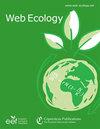旱地道路斜坡生物土壤结皮的无辅助建立
IF 2.4
3区 环境科学与生态学
Q2 ECOLOGY
引用次数: 12
摘要
摘要了解人为干扰后生境自然恢复的模式对保护干旱等高环境压力环境下的生态系统至关重要。特别是,在新形成的栖息地中,非维管植物如生物土壤结皮、土壤结皮群落(如土壤地衣、苔藓和蓝藻)的独立建立尚不完全清楚。然而,生物结壳在演替初期改善土壤结构和功能、促进生态系统恢复方面的潜力是巨大的。在这项研究中,我们评估了地衣生物结壳在地中海灌木地道路斜坡上自发建立和发展的能力。我们还比较了道路坡地与周边自然生境间生物结皮的分类和功能多样性。对13公里公路沿线17个坡面(9个路堑和8个路堤)的生物结皮丰富度和覆盖度、物种组成和功能结构进行了测量。研究了道路坡地的地形、土壤性质和维管植物群落特征。我们使用Kruskal-Wallis测试和应用冗余分析(RDA)来测试环境情景(道路坡度与自然栖息地)和其他当地因素对生物结皮特征的影响。我们发现,在不需要人工帮助的情况下,经过约20年的施工,道路斜坡上的生物结壳很常见。但物种丰富度和盖度仍低于自然遗迹。此外,路堑(即土壤开挖后)和自然遗迹之间的功能结构非常相似,地形和土壤性质影响物种组成,而环境情景类型和维管植物覆盖不受影响。这些发现进一步支持了生物结皮作为干旱地有希望的恢复工具的观点,并证实了土地利用变化情景下土壤因子在生物结皮建立和发展中的关键作用。本文章由计算机程序翻译,如有差异,请以英文原文为准。
Unassisted establishment of biological soil crusts on dryland road slopes
Abstract. Understanding patterns of habitat natural recovery after
human-made disturbances is critical for the conservation of ecosystems under
high environmental stress, such as drylands. In particular, the unassisted
establishment of nonvascular plants such as biological soil crusts or
biocrust communities (e.g., soil lichens, mosses and cyanobacteria) in newly
formed habitats is not yet fully understood. However, the potential of
biocrusts to improve soil structure and function at the early stages of
succession and promote ecosystem recovery is enormous. In this study, we
evaluated the capacity of lichen biocrusts to spontaneously establish and
develop on road slopes in a Mediterranean shrubland. We also compared
taxonomic and functional diversity of biocrusts between road slopes and
natural habitats in the surroundings. Biocrust richness and cover, species
composition, and functional structure were measured in 17 road slopes (nine
roadcuts and eight embankments) along a 13 km highway stretch. Topography, soil
properties and vascular plant communities of road slopes were also
characterized. We used Kruskal–Wallis tests and applied redundancy analysis
(RDA) to test the effect of environmental scenario (road slopes vs. natural
habitat) and other local factors on biocrust features. We found that
biocrusts were common in road slopes after ∼20 years of
construction with no human assistance needed. However, species richness and
cover were still lower than in natural remnants. Also, functional structure
was quite similar between roadcuts (i.e., after soil excavation) and natural
remnants, and topography and soil properties influenced species composition
while environmental scenario type and vascular plant cover did not. These
findings further support the idea of biocrusts as promising restoration
tools in drylands and confirm the critical role of edaphic factors in
biocrust establishment and development in land-use change scenarios.
求助全文
通过发布文献求助,成功后即可免费获取论文全文。
去求助
来源期刊

Web Ecology
Agricultural and Biological Sciences-Ecology, Evolution, Behavior and Systematics
CiteScore
4.60
自引率
0.00%
发文量
6
审稿时长
17 weeks
期刊介绍:
Web Ecology (WE) is an open-access journal issued by the European Ecological Federation (EEF) representing the ecological societies within Europe and associated members. Its special value is to serve as a publication forum for national ecological societies that do not maintain their own society journal. Web Ecology publishes papers from all fields of ecology without any geographic restriction. It is a forum to communicate results of experimental, theoretical, and descriptive studies of general interest to an international audience. Original contributions, short communications, and reviews on ecological research on all kinds of organisms and ecosystems are welcome as well as papers that express emerging ideas and concepts with a sound scientific background.
 求助内容:
求助内容: 应助结果提醒方式:
应助结果提醒方式:


